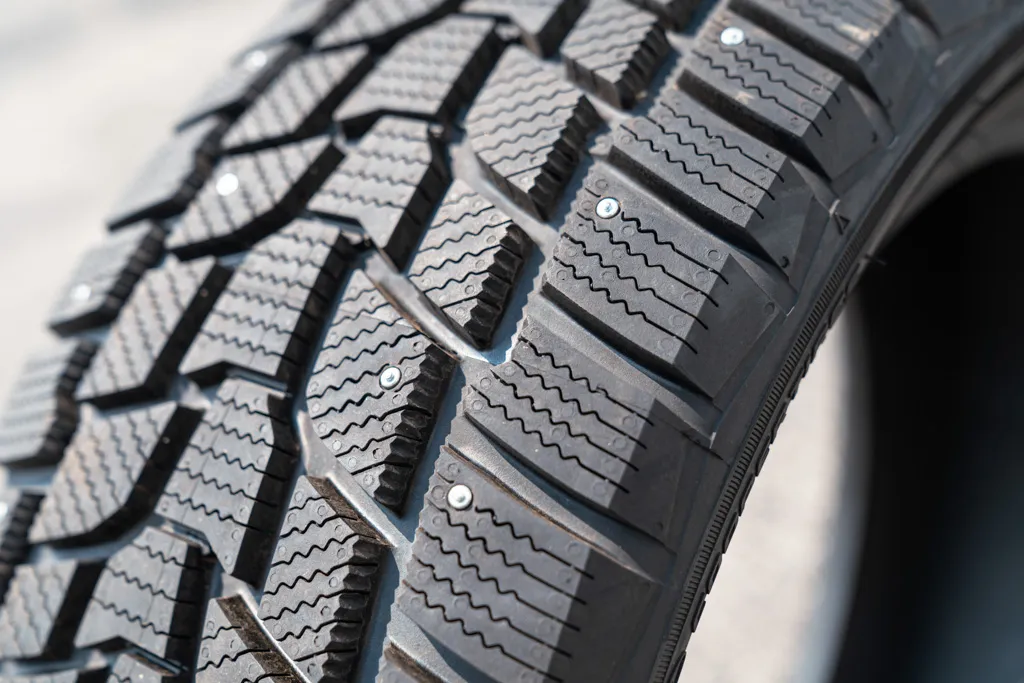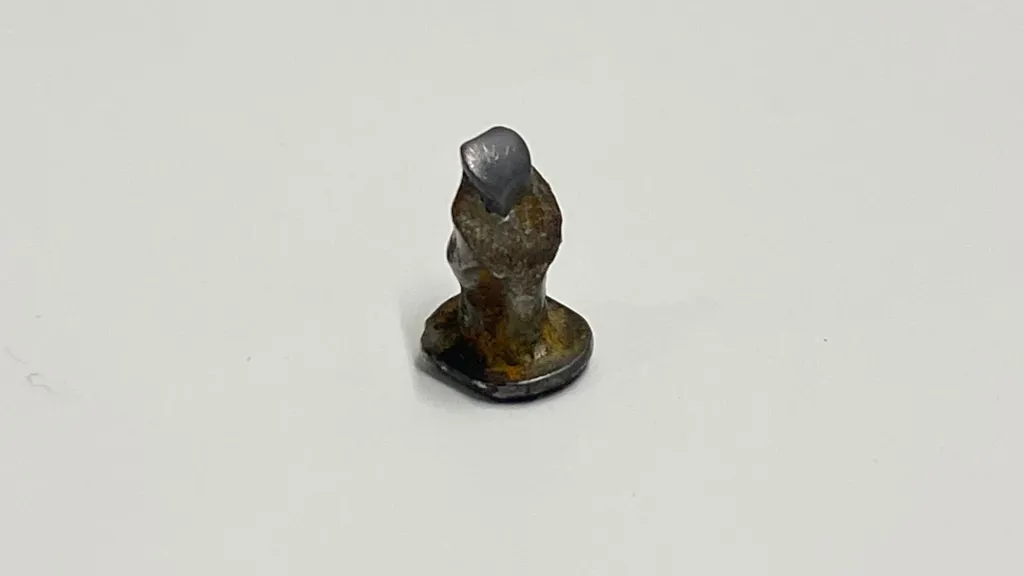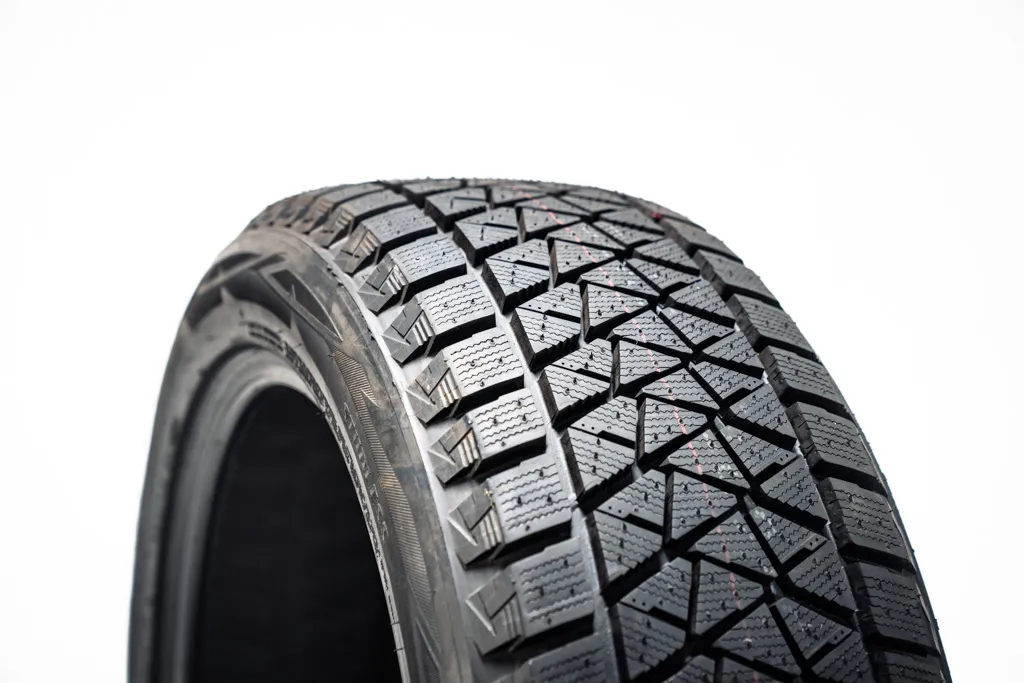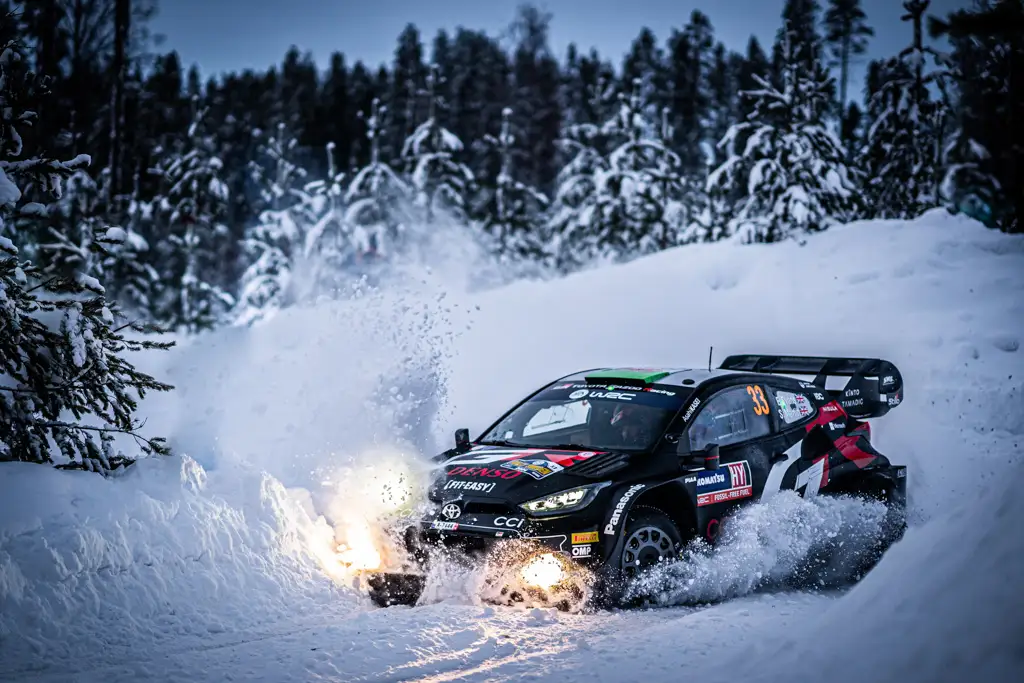Last Updated on 28.08.2024 by hrushetskyy

Studded tires are winter tires with metal or rubber studs embedded in their tread. They offer great grip and traction on ice; however, studded tires wouldn’t be the best choice for paved roads or deep snow. Let’s explore those studs and understand whether you need them on your winter tires.
Why do I need studded tires?

All winter tires are manufactured to withstand extreme weather conditions. However, the level of their “reinforcement” depends on how harsh these conditions are.
Seventy percent of the US population lives in the snowy regions. The Federal Highway Administration records a high rate of road accidents when winter comes. Over 1,300 people are killed, and more than 118,800 are injured annually due to crashes on snowy and icy roads. Twenty-four percent of weather-related car crashes occur on snowy or icy pavements, and 15 percent during snowfall or sleet.
You probably wouldn’t argue that the toughest road surface for any driver is slick ice — unpredictable and deceptive. When the roads begin to glaze, you face the challenge of maintaining control of your vehicle in treacherous driving conditions. Choosing the right winter tires is crucial and must always be your number one safety priority.
Studded tires 101
The big advantage on smooth ice
With metal studs embedded into the tread, studded tires are specially designed to bite into slick surfaces. They provide a significant advantage on smooth ice, where their traction capabilities shine. With over 100 (and up to 250) metal studs embedded in the tread, they act like a velcro, gripping the icy road’s surface.
In contrast to studdable tires, the metal studs in these winter tires cannot be removed (or added back). That’s why they are the choice of car owners who live in the north and mostly drive on ice, not even in snow and ice.
Studs explained
Winter tires designated for different vehicles require different studs embedded in their tread. They will have a slightly different design, diameter, length, and shape to withstand the weight, the driving style, and other characteristics and conditions.
Tire studs look like a screw without threads, with a stainless steel or aluminum body and a carbide tip. Passenger or light truck tire studs would have a length of 0.39-0.62″ and a weight of 0.03-0.05 lbs each.
On one end is a cup, and on the other is a so-called stud jacket with a small pin. This is what would grip the ice and give you control.
The studs are installed in the tread with an inactive “cup” end — and the pin of a stud jacket, when in place, protrudes over the tread for about 1/32″. This is a manufacturer characteristic of a new set.
Studs’ wear

The wear of the stud plays a very important role in vehicle performance on the ice. The level at which the studs protrude over the tread would affect the traction of the rubber on ice. Friction with the icy road surface significantly decreases if the studs are worn to 0,024″.
However, if stud protrusion remains at 0,039″ to 0,043″, tire tread wear has a slight frictional effect. When purchasing used studded tires, you should keep these numbers in mind.
Weather conditions and studded tires
According to An Overview of Studded and Studless Tire Traction and Safety conducted by the Washington State Transportation Center, the roads in two representative states with harsh winter conditions—Alaska and Minnesota, are icy 12% to 13% of all usual winter time. Winter tires, providing optimal vehicle handling, are a good choice.
When to use studded tires?
Driving on tricky surfaces requires strategic planning and the use of perfect winter tires. You want solid contact with the roads and the ability to control any situation.
A winter tire with studs performs the best on ice in temperatures near the freezing mark (around 32 °F).
When not to use studded winter tires?

Different kinds of winter tires are manufactured for different weather conditions. And, likely, you don’t need a studded tire at all. Here are 4 common road situations that don’t require buying them.
- Deep or packed snow
The best solution is a snow winter tire. It is designed for optimal traction in deep or packed snow, on wet, slush, or lightly snow-covered roads. A brutal tread design with big blocks, deep groves, and multiple sipes helps to track through different snowy conditions by providing good grip, water channeling, and confident traction in the cold to very cold weather. Michelin X-Ice Snow follows all these characteristics and provides a safe ride in the snow.
2. Pavement and concrete
Driving them on asphalt and concrete would not only damage the road’s surface and make noise but also cause a really dangerous situation: a studded tire would lose its performance—the studs would wear much faster, as would the tire itself.
If you need to drive on icy, cold roads occasionally and on dry or paved roads, choose new or used studdable tires. You can add or remove studs from the tread whenever you need — and get that versatile winter performance you’re looking for. Goodyear Ultragrip Winter is one of the best studdable tires in our catalog. You can choose from both new and used listings.
3. Both — snow and ice
If you are looking for a mixed performance for extreme winter conditions—and need to be driving in snow and ice—go for a general category of winter tires with sidewalls marked with a three-peak mountain snowflake symbol. These tires have a pronounced tread pattern with big blocks, sipes, and deep grooves and are made of a soft rubber compound that grips the tricky winter road really well.
Eco-friendly Yokohama Ice Guard IG 52C suits ice and snow-covered surfaces only if the snow isn’t too deep. If you want a versatile winter tire with good ice performance, check out Nokian Nordman 7.
4. Dry or wet roads
If you don’t live somewhere in the North and the roads in your state are not constantly covered with snow or ice, you might not need a winter tire at all. If average winter temperatures don’t drop below 45 °F, and the roads become only moderately snowy, the optimal traction might be provided by all-season tires that are suitable for mild weather conditions, including summer. Season tires have to be chosen really wisely for the vehicle to drive you safely on different surfaces. Pirelli P4 Four Seasons Plus is a good choice for that.
When to choose studless tires instead of studded ones?

Another option is studless tires—a modern category of winter rubber manufactured from specialized compounds with specialized tread designs. They offer impressive traction on snow and ice, and more and more drivers choose them for winter. However, if most of your routes lie through sleek ice, we recommend getting studded tires.
Differences between studded and studless tires
| Description | Advantages | Disadvantages |
| Studded tires | ||
| Winter tires with 100-250 studs embedded in the tread. Studs have a stainless steel or aluminum body and a carbide tip | Optimal traction on sleek ice | Aren’t suitable for long driving on paved roads Lose their traction in deep snow Older models can damage the tarmac Older models can be noisy — the latter two disadvantages are the reason behind studded tire bans in some states and countries. |
| Studless tires | ||
| Modern winter tires that are manufactured from advanced rubber compounds with specialized tread patterns and do not rely on metal protrusions for better winter traction | Optimal traction in harsh winter conditions—snow, slush, moderate ice | Aren’t suitable for car owners, predominantly driving on icy roads in harsh conditions and temperatures—studded tires and chains are recommended |
Are studded tires legal in the USA?
Yes, they are legal in the USA. Most of the states allow their use with date restrictions—and they would depend on weather conditions. So if winter comes early, like in Arizona, freezing temperatures solidly settle up and roads become icy, studded tires can be allowed as early as October the 1st. Most likely, the winter season lasts long there, too, and you must change the rubber on May 1st.
In contrast, in Chicago, where the headquarters of United Tires is located, we cannot drive on winter tires studded with metal bolts under any circumstances.
Why are studded tires illegal in some places? color-coded map
Driven on bare pavement and concrete, a studded tire can damage the tarmac and make noise. But also—produces dust particles that are considered harmful to health. This is why studded tires have been banned in Japan since 1992.
The USA is not so strict, but state laws are created to protect citizens’ safety and the environment. The restrictions vary depending on the local weather conditions.
But there is no doubt that a studded winter tire provides safety benefits and vehicle control by providing a solid grip with ice, confident traction, and handling even on the most extreme icy roads. Keep in mind that modern studded tire production has significantly progressed—the technology, the compounds, and the materials are much less harmful to the tarmac and the ears of residents of snow-covered areas.
Which states allow studded tires, and which don’t?
As mentioned earlier, studded tires are allowed for driving in winter conditions in most states with date restrictions.
Legal without restrictions
Studded winter tires can be used without any restrictions all year around in:
- Colorado
- Kentucky
- New Hampshire
- North Carolina
- South Carolina
- Vermont
- Wyoming
Not legal, but there are exceptions
- Alabama
- Alaska
- Georgia
- Minnesota
- New Mexico
- Hawaii
- Washington DC
- Wisconsin
For more information, see the table below.
Top 5 UTires’ recommended studded tire models
- Michelin X Ice North 4
- Nokian Hakkapeliitta 10
- Goodyear UltraGrip Arctic 2
- Continental IceContact 3
- Hankook Winter i pike RS2
The psychology of driving with studded tires
In one Norwegian study, the researchers came to an interesting conclusion. People owning studded tires belong to a category of drivers who care about their safety more than others. But, feeling that extra confidence, they tend to drive faster—and go out in weather conditions that the owners of studless tires usually stay away from. Keep in mind that metal studs in your tires do not give you superior powers on frozen, icy roads. But yes, the ability to retain contact would be undoubtful.
“Do studded tires really work?” Check out these three studies’ results

Yes. They do. Any tire performance is defined by the quality of traction in certain weather conditions. And it includes such characteristics as acceleration and deceleration, braking, controllability, cornering, etc. For winter studded tires, two indicators are extremely important: braking distance and deceleration. These evident advantages of a studded tire are hard to beat.
1. They help to avoid misjudging the braking distance
Studs help increase friction during locked-wheel braking—which significantly helps the drivers judge the braking distance. The car won’t slide on ice when slowing down is necessary. This is testified by the study results organized by the Pennsylvania Transportation Institute.
2. Their shorter stopping distance in extreme conditions is much higher than that of studless tires
The results of the test, conducted by the University of Alaska at Fairbanks, showed that studded tires had a 15% shorter stopping distance on ice than non-studded winter tires. And in comparison to all-season tires, traction was 40% higher! However, on bare pavement, all three categories of tires (studded, studless, and all-season) showed similar results.
3. They over-perform snow tires on ice
In a study by the Pennsylvania Transportation Institute, studded tires over-performed snow tires in locked wheel braking tests, which measured tire friction on the ice at 20 mph speed. During these tests, four-wheel drive (surprise!) showed much better controllability and traction (though not showing better braking results).
A studded tire provides the most confident grip on an uneven ice road surface. But packed or deep snow needs a different tire configuration—a tread pattern with deep treads, multiple sipes, and significant groves. Protruding metal studs would dangerously decrease traction in these conditions.
Frequently Asked Questions
How many studded tires do I need?
Four. And it’s not negotiable. Safety and best traction can be only provided by an equal number of same-performance tires. And it is especially important if you live in the northern part of the country.
Can I drive on studded tires all year round?
You absolutely cannot! Once the temperature consistently climbs over 45 F, you must change into all-season or summer tires.
How fast can you drive with studded tires?
Studded tires have lower speed indexes—in our catalog, you will mostly find S (112 mph max), T (118 mph max), and U (124 mph). For the first 60 miles driven, a speed of 31 mph is recommended without hard braking or acceleration.
When can studded tires be put on?
It depends on the part of the country you live in. For example, in Indiana, you can put them on as early as October 1st — and take them off as late as May 1st. Y
When are studded tires worn out?
These tires generally serve you well for four winters. A lively discussion on one of the popular car forums concluded that studs usually wear by half in three winters.
Where to buy studded tires?
This is your choice. The modern tendency of the post-pandemic world — is to shop online. For example, the United Tires website lists thousands of used and new tire models. Choose the ones you prefer and give us your address: we deliver right to your door for free.
How much are studded tires?
They are usually cheaper than the studless ones. In our catalog of studded tires, prices start as low as $47,99 per tire. You can also find driven only once tires. For example, Firestone Winterforce 2 UV.
When winter tire studs wear out?
When the stud’s length gets to 0.2 inches point, in this case, you must replace the tires. In case you’re driving on studdables—replace the studs.
Share the Knowledge
